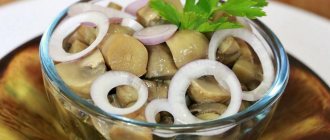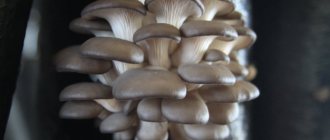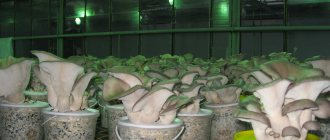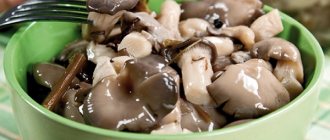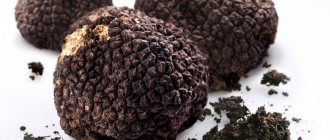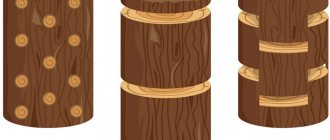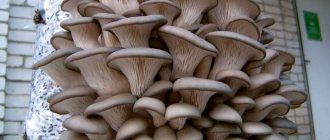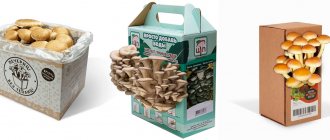Oyster mushrooms are considered mushrooms from the department Basidiomycota and the class Agaricomycetes, in order they are agaricaceae from the family Oysteraceae, although sometimes it is called pleurotaceous due to the genus oyster mushroom, denoted in Latin by the word - Pleurotus.
They can grow independently in the wild or be specially raised under human supervision.
These mushrooms are highly valued by residents of English-speaking countries; they call them oyster mushrooms, because they find some similarities with an open oyster.
The Japanese perceive oyster mushroom as a flat mushroom. And in Russia, mushrooms from this family began to be called oyster mushrooms because of the way they are grown, since they grow in a suspended state.
Description
The cap of the oyster mushroom is fleshy. At first it is convex and then becomes smooth. In mature specimens, it has the shape of a shell (in Latin ostreatus - oyster) like an oyster.
The surface of the mushroom caps is smooth and shiny, wavy. At the beginning of growth, the cap is indistinguishable from the stem. It then takes on an oyster shape and then changes to a spatula or fan shape once the mushroom reaches maturity. A recess is formed at the top.
Mushroom color options
The color of the oyster mushroom cap varies from dark gray with purple hues to the color of light and even dark hazelnut.
Purple oyster mushrooms
The tone that the mushroom takes is brownish-dark, brownish-reddish, from black-violet to blue-blue at the final stage of fruit development. Before dying, the mushroom turns pale and white.
Gray oyster mushrooms
The leg is developed and short. Due to its irregular cylindrical shape, the mushroom appears squat.
Oyster mushroom habitat
Oyster mushroom is a saprophytic fungus and only occasionally a parasitic fungus. Attaches to the stumps of poplars and mulberries. Oyster mushrooms develop in small groups, very close to each other. Often the mushroom caps overlap one another, like tiles on a roof.
These mushrooms develop on trunks even at a considerable height from the ground. They grow on broad-leaved and rarely coniferous trees. Oyster mushrooms are also common in city parks and on the edges of roads and highways. This mushroom grows from plains to mountains and there are no difficulties with growing oyster mushrooms.
Oyster mushroom is widespread in many temperate and subtropical forests around the world; the mushroom does not grow in the Pacific Northwest of North America. It is a saprophyte that in nature decomposes dead wood, especially in deciduous and beech plantings.
Oyster mushroom is also one of the few known carnivorous mushrooms. Its mycelium kills and digests nematodes, which biologists believe is the fungus's way of obtaining nitrogen.
Oyster mushrooms grow in many places, but some species develop colonies only on trees.
This fungus most often grows on dying deciduous trees; it acts on them only saprophytically, and not parasitically. As the tree dies from other causes, oyster mushrooms receive a rapidly growing mass of already dead and dying wood to grow. Oyster mushrooms actually benefit the forest by breaking down dead wood and returning vital elements and minerals to the ecosystem in a form that can be used by other plants and organisms.
Varieties of oyster mushrooms
Oyster mushroom is a type of oyster mushroom; popularly it is often called oyster mushroom, or bun, or plane tree, or hanged mushroom. Of all the representatives of this mushroom family, this species is considered the most useful and valuable in its composition.
There are nine known species of oyster mushrooms:
- Ordinary.
- Autumn.
- Oak.
- Abundant.
- Pulmonary.
- Steppe.
- Pink.
- Sheathed.
- Shlyapkovaya.
Autumn oyster mushroom is popularly called willow oyster mushroom. It is usually collected in the first autumn months. Whole families usually grow on maple and poplar stumps; less often they can be found on the stumps of linden, aspen and elm trees. Externally, it is slightly different from other types: the cap is not only elongated, but also slightly one-sided. Its color changes as the plant ages. A young pig's cap is gray-white, and then gradually it acquires a dirty yellow tint. The leg is very short and does not exceed a length of 2.5 centimeters.
Oak oyster mushrooms are also considered edible. It is not very common, as it grows only on oak stumps or trunks. It appears in July and can be collected only until August. The cap is round, its diameter is usually less than 10 centimeters. To identify this species, just look carefully at the mushroom cap: it will be slightly curled around the edge, and a white blanket will be visible from it. The color shade is most often cream or yellowish.
The leg of the oak oyster mushroom also has its own characteristics. So, it is covered with scales and velvety. Its length does not exceed 10 centimeters. The cylindrical leg can be attached to the cap either in the center or on the side. Despite the fact that the mushroom has a pleasant aroma, its flesh is somewhat harsh.
Wild oyster mushrooms Oyster mushroom in nature
Growing oyster mushrooms at home
For growing mushrooms, stores sell boxes/bags with substrate and oyster mushroom spores, and they are convenient to grow at home.
Growing mushrooms brings great satisfaction and is beneficial for the family budget. There are two ways to grow this and other mushrooms. The first method is “manual” cultivation on the ground in a garden or greenhouse. The second, recommended one, is “industrial” cultivation using substrates (bales) already prepared by enterprises for use at home.
How to cook?
You can prepare many dishes from oyster mushrooms. This product perfectly complements soups, can be part of a sauce or add a touch of pleasant aroma to the filling of pies or dumplings. Oyster mushrooms can also be frozen. To do this you need to take several steps:
- Rinse the grapes well under running water.
- Cut off and discard the base. It is usually very tough even after boiling.
- Chop the mushrooms. The pieces must be large enough, as they will shrink after cooking.
- Boil the preparations in salted water with allspice.
- Cool and divide into small containers.
It is better to divide the workpiece into several small portions. It is very comfortable. This way you won’t need to defrost the entire bag in order to take 100 grams of product for soup or other dishes.
Let's fry
Frying a mushroom is the most appetizing and fastest way to prepare it. Oyster mushrooms fried in a frying pan can complement absolutely any culinary masterpiece.
Cooking method
- Wash, peel and cut the product.
- Place it in a frying pan with a small amount of vegetable oil. It is important not to overdo it, as mushrooms that have absorbed the oil become very difficult for the stomach. And besides, all their taste charm is immediately lost.
- Fry over low heat for 5 minutes.
- After the oyster mushrooms have given a lot of juice, you can add salt and season them with spices. Cover with a lid and wait for the moisture to evaporate.
The resulting preparation can be seasoned with cream or sour cream. It can be used for soups and warm salads.
Cooking soup
We already have fried mushrooms ready. You can use them to prepare a flavorful and very satisfying dish - creamy soup.
Compound
- Oyster mushroom – 150 grams.
- Potatoes – 4 pieces.
- Hard cheese – 100 grams.
- Broth – 2 liters.
- Bulb.
- Fresh greens.
- Salt and spices.
Cooking method
- Add diced potatoes to the broth and place over low heat. Add salt.
- When the potatoes become soft, add pre-fried oyster mushrooms to the soup.
- Peel the onion, rinse and add to the broth. No need to chop the onion.
- Add spices.
- Cook the soup with potatoes, onions and mushrooms for 5 minutes.
- When the broth boils, remove and discard the onion. Add finely chopped greens.
- After 5 minutes, add 100 grams of grated cheese. Cook for 3 minutes.
- Remove the pan from the heat and let the soup brew.
Croutons will be an excellent addition to the dish. You can make them yourself.
Growing oyster mushrooms manually “on the ground”
During the cold season, trunks are cut, possibly from poplar, with a diameter of more than 20 cm. The winter period is important because the tree must stop growing. Once trimmed, the stumps are stored upright in a shady area to await use, which usually occurs between April and June.
30 cm segments are cut from the trunks, holes are dug 1 meter wide and 120 cm deep. A layer of mushroom mycelium is placed at the bottom of the pit, and vertically located trunks are placed on top. Then another layer of mycelium and a trunk, and so on. The upper part is covered with boards and a 15 cm layer of soil is poured.
The heat and humidity that forms inside the pit will facilitate the distribution of mycelium over the logs laid inside. In September, the trunks are removed and buried one by 15 cm, at a distance of 30 cm from each other. In about twenty days, oyster mushrooms will begin to grow, which is repeated in each subsequent season.
Growing oyster mushrooms on an industrial substrate in bags
This is a growing method that everyone can comfortably use right in the home without the need to dig the ground or have free space in the yard.
In this case, they do not use chopped trunks, but bags with a substrate consisting of straw from corn, wheat and legumes. This compound is inseminated with mycelium cultures and then placed in a plastic container.
The bale made in this way is ready for incubation, this period lasts about 20 days and takes place in a place with a temperature of about 25°C. As soon as the mycelium has penetrated the entire bag of substrate, remove the plastic and place the bag on a shelf in a sunny or artificially lit place and maintain the temperature at about 15°C.
Oyster mushrooms grow in cycles in bags of substrate. The growth period is artificially interrupted by lowering the room temperature.
3 ways to grow oyster mushrooms - video
What do oyster mushrooms taste like?
Cooked oyster mushrooms have a smooth, oyster-like texture, and some people report a slight seafood flavor. Gourmets believe that oyster mushrooms have a subtle anise aroma.
Both flavors are subtle and generally undetectable once mushrooms are added to a main dish. In general, oyster mushrooms have a mild flavor with a slight earthy undertone.
Is it possible for children?
Full consumption of mushrooms is not recommended for preschool children. The product is heavy and high in calories, it can lead to intestinal upset and nausea in the baby. In general, you can give oyster mushrooms to a child from 2 years of age. In this case, the serving should be no more than half a teaspoon. Pediatricians give the following recommendations:
- Do not feed this product to children under 2 years of age. The child's body is simply not able to absorb large amounts of microelements and protein. This applies to all types of mushrooms. Even a small piece of the fruiting body can cause harm.
- From the age of two you can use the product. The main thing is that it is environmentally friendly and not heavily seasoned or salted. You can eat no more than 2 pieces of mushroom and no more than once a week.
- Mushroom soup can be given to children from 5 years old.
- From 6-7 years old, a child can be treated to casseroles and pies. Portions should still be small.
- Starting from 10-11 years old, a child can eat oyster mushrooms until he is completely saturated. At this age, the body can cope with fried and stewed dishes made from this product.
By following these simple rules, parents can be sure that oyster mushrooms will not harm the health of their baby.
Oyster mushroom recipes
The gastronomic interest in mushrooms is due to two factors. First of all, it is good edibility. Secondly, oyster mushrooms are easy to grow.
Oyster mushrooms are prepared in various ways. Baked, breaded and fried mushrooms are quite common in many cuisines around the world. As a rule, oyster mushrooms are grilled, breaded with butter or stewed. They also taste excellent when preserved in oil.
Cooks recommend throwing away the leg because it is not very tender and is too hard. Oyster mushrooms are cleaned and chopped, like all other types of mushrooms.
Fried oyster mushrooms
Oyster mushrooms are great for cooking in a pan with or without other ingredients. They are also perfectly breaded, as if they were cutlets, especially if they are soft young specimens.
Oyster mushrooms in seasoning
After boiling briefly for a few minutes, the mushrooms are eaten seasoned with oil, lemon, salt and pepper.
Stuffed oyster mushrooms
After a few minutes of pre-cooking, the mushrooms are poured with mayonnaise and seasoned with parsley and finely chopped green onions. To boil oyster mushrooms for this recipe, add vinegar and salt and pepper to the water. Professional chefs recommend using young specimens.
Oyster mushrooms in oil
Oyster mushrooms, when placed in oil or vinegar, retain their meatiness. Thanks to this property, oyster mushrooms are suitable for fillings, rice salads and other recipes.
Dried oyster mushrooms
These mushrooms are also suitable for drying and chopping. In this case, it is advisable to add mushroom powders that are more aromatic than oyster mushrooms to the mixture.
Collection rules
Oyster mushrooms should be collected as carefully as porcini mushrooms. First of all, you need to use a knife. It is better to cut such plants as a whole group. If there are young mushrooms in the group, then they should also be cut off, since they will die alone.
MUSHROOMS: OYSTER MUSHROOMS. Oyster Mushroom
The best mushrooms for harvesting are those whose cap diameter does not exceed ten centimeters. If its size is larger, then this is the first indicator of the old age of the mushroom; it is unsuitable for cooking: old oyster mushrooms are tasteless and rather tough.
Nutritional and medicinal value of oyster mushrooms
For 100 grams of mushrooms there are:
- 38 calories;
- 15-25 g protein;
- 6.5 g carbohydrates;
- 2.2 g fat;
- 2.8 g fiber;
- 0.56 mg thiamine;
- 0.55 mg riboflavin;
- 12.2 mg niacin;
- 140 mg phosphorus;
- 28 mg calcium;
- 1.7 mg iron.
Oyster mushrooms have a wide range of nutritional and medicinal properties. Like most edible mushrooms, they are an excellent source of protein, carbohydrates and fiber, and are low in fat. The mineral composition of mushrooms varies depending on the species and substrates used.
Typically, oyster mushrooms contain the following minerals: Ca, Mg, P, K, Fe, Na, Zn, Mn and Se. They are also a source of vitamins B1 and B2, thiamine, riboflavin, pyridoxine and niacin.
Oyster mushrooms are considered a functional food due to their ability to have positive effects on human health. Some scientific works report antimicrobial and antiviral properties of oyster mushrooms. Their methanol extracts inhibited the growth of Bacillus megaterium, S. aureus, E. coli, Candida glabrata, Candida albicans and Klebsiella pneumoniae.
Ubiquitin, an antiviral protein, is also found in the oyster mushroom fruiting body. In particular, fungi contain ribonucleases that destroy the genetic material of the human immunodeficiency virus (HIV). A similar effect is exerted by the lectin protein isolated from the oyster mushroom fruiting body.
Polysaccharides obtained from oyster mushroom mycelium demonstrate antitumor activity. Doctors observed a 76% reduction in tumor cells when a polysaccharide from a culture broth was administered intraperitoneally to female Swiss albino mice.
Notably, oyster mushroom extracts showed antitumor activity against certain types of lung and cervical sarcomas. The level of antioxidants in the fruiting bodies is also reported to be higher compared to other commercial mushrooms.
Oyster mushrooms also exhibit hypolipidemic and antihyperglycemic properties. Mevinolin lowers cholesterol levels. In addition, oyster mushrooms produce a compound for use in antidiabetic medicine. A study found that oral administration of aqueous extracts of oyster mushrooms in diabetic mice reduced blood glucose levels.
Many species of oyster mushrooms contain bioactive compounds such as glucans, vitamin C and phenol, which enhance the action of certain enzymes that reduce liver cell necrosis. Oyster mushroom extracts are also reported to lower blood pressure, have immunomodulatory activity and anti-aging properties.
Oyster mushrooms promote weight loss. Oyster mushrooms, due to their high protein content and low fat and carbohydrate content, help in weight loss. Therefore, if you are losing weight, be sure to include oyster mushrooms in your diet.
Harm of oyster mushrooms
The beneficial properties of oyster mushrooms are undeniable and numerous. But these mushrooms can also be harmful to humans.
The most obvious sign that the body does not accept oyster mushrooms in large quantities is abdominal pain after a person has eaten too many mushrooms in any form, fried or boiled. There are no other specific contraindications. Intemperance in eating is a sign that the eater has forgotten about the sin of gluttony, and not a side effect of the mushroom. In large quantities, oyster mushrooms provoke bloating, increased gas formation in the intestines, lead to diarrhea and other dyspeptic disorders.
All mushrooms, including oyster mushrooms, take a long time to digest in the gastrointestinal tract. This is good for the body, which extracts more nutrients, but bad for a sensitive stomach. Oyster mushrooms cause pain in the epigastric region in children and the elderly.
Oyster mushrooms are allergenic to sensitive organisms. Therefore, they are used with caution in case of food allergies.
Like any other mushrooms, oyster mushrooms are consumed only after treatment with heat, since the chitin in the raw mushroom is dangerous to humans.
Video gallery
Video reviews
A selection of videos with descriptions and recipes for preparing mushrooms
about Mushrooms and Plants in Your Own Words, Grilling, Cooking for men
